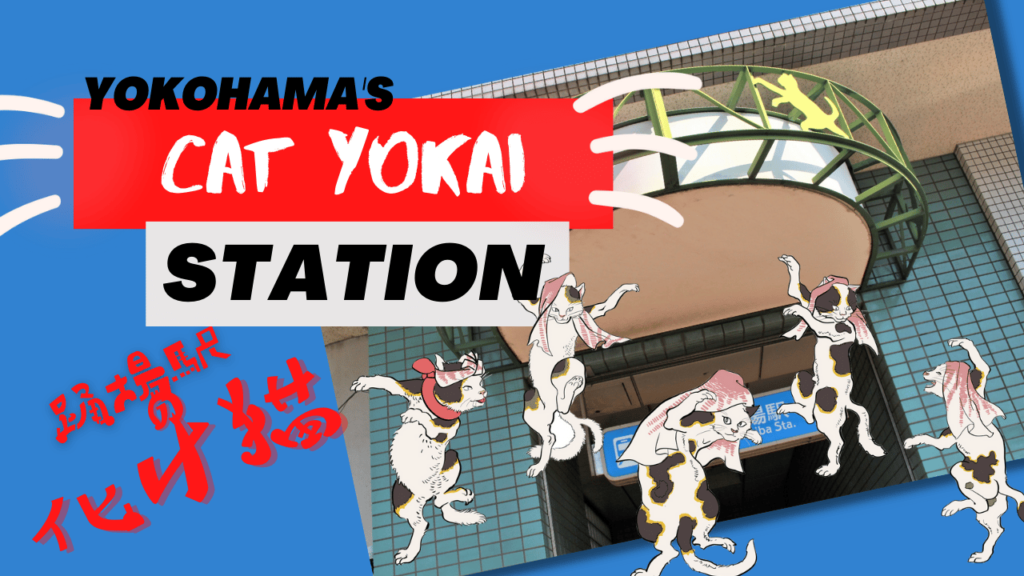[ad_1]
Upon entering Odoriba Station, an underground metro station in Yokohama’s Izumi Ward, visitors are immediately swept into a mysterious feline underworld. Mosaics and murals on the station’s walls feature enormous yellow, slit-pupiled eyes watching passengers’ every move and step. Trails of pawprints on walls and floors help guide travelers to their destination. Even the station’s tickets feature images of a cat poised mid-dance step. But Odoriba Station does not honor ordinary domesticated felines. These are bakeneko, one of Japan’s most iconic yokai.
Yokai roughly translates to “strange/bewitching apparition.” It is a broad category referring to hundreds, if not thousands, of mythical creatures originating from Japanese folklore. Yokai are generally believed to live in the human world, but tend to prefer to stay hidden. When yokai choose to interact with humans, their behavior can range from genuine help to simple pranks to threatening danger. The category of yokai includes both well-known legendary figures such as the kitsune (shapeshifting foxes) or the kappa (turtle-like beings who dwell in rivers) and more obscure creatures like the nurikabe, a sentient wall that impedes travelers’ progress. Today, yokai are common fixtures in classic legends, horror films, and even children’s television such as the long-running Yokai Watch series. [1]

Bakeneko: Paw-sitively Mysterious
The word “bakeneko” (化け猫) literally means “changed cat.” The name derives from the belief that bakeneko begin their life as ordinary cats. They transform into yokai once they have lived for a certain number of years. Different variants of the legend claim that the age at which a cat turns into a bakeneko is alternately seven, twelve, or thirteen years. Other stories state that bakeneko are instead cats who were killed by humans. Once transformed, they take revenge on their owners. A cat with a long tail is more likely to become a bakeneko.
Bakeneko generally continues to resemble ordinary cats. They may increase in size or develop the ability to walk on their hind legs. According to legends, a bakeneko can be identified by the pupils of its eyes constantly changing shape, its fur emitting lightning-like sparks, or its tendency to wear a cloth or napkin covering its head. It’s sometimes easy to confuse bakeneko with nekomata, another cat-like yokai. However, bakeneko have only one tail while nekomata have two. [2]

Playful Pranksters or Focused Revenge-Seekers?
Stories about bakeneko alternately portray them as pranksters and vicious monsters with a focus on revenge. Prankster-type bakeneko are more likely to perform small acts of mischief, such as drinking all of the lamp oil in a house and leaving the owners unable to light their lamps. This belief may originate from true events in which stray cats who did not get enough fat or protein in their diet did in fact seek out lamp oil as food.
Some bakeneko have the ability to shapeshift into a human form, and use this form to participate in human activities such as dancing or sumo wrestling. More vicious bakeneko will attack and even kill humans, especially those that have been cruel to cats. Bakeneko who had kind owners may instead seek revenge on those who did their owners wrong.
The most famous bakeneko legend, the “Nabeshima Disturbance,” tells of Nabeshima Mitsuhige, a daimyo in what is now Saga Prefecture, who was tormented and possibly killed by bakeneko. These bakeneko are believed to have once been the house cats of the Ryuzoji, a rival clan that had been overthrown by the Nabeshima clan. One variation on the legend claimed that the bakeneko tricked Mitsuhige by shapeshifting into beautiful courtesans. [3] Today, bakeneko are still strongly associated with women, and bakeneko roles in most theatrical ghost plays are played by female actresses or kabuki onnagata (female impersonators.)

Odoriba: The Place Where Cats Danced
The bakeneko associated with Yokohama’s Odoriba Station, fortunately, are the playful type rather than the vengeful. The name “Odoriba” means “dancing place” and comes from a local legend in which humans witnessed a group of bakeneko dancing together on their hind legs. According to the legend, there was once a soy sauce shop in the location where the station is today. The owner and his wife took good care of the shop’s tenugui – thin cotton towels used for wiping hands, similar to napkins – but the towels constantly went missing.
One night, the owner went out to search for the missing tenugui. As he searched, he began to hear music from a vacant area where no homes or shops were. He followed the music to find a group of cats standing on their hind legs, speaking human language and dancing to the music. Each of the cats was wearing a tenugui towel on top of its head. The leader of the group of cats was none other than the owner’s very own pet cat! From that day on, the owner’s wife set aside special tenugui for the cats to use. Thus, they no longer had to steal from the shop. [4]
In addition to Odoriba Station’s feline makeover, residents erected a shrine to the “dancing cats” at an intersection near the station. Both the station and the shrine are meant to pacify the spirits of the cats, encouraging them to remain peaceful and coexist with humans. Today, offerings given by visitors to the shrine include small statues of cats, cat treats and other food items, and, of course, napkins and hand towels for the cats to wear while they dance. [5]

Dancing Cats Could Herald Disaster
While the dancing bakeneko of Odoriba seem to have been simply enjoying themselves, dancing cats in Japan have come to have a far more sinister meaning in recent years. In the 1950s, an outbreak of cats “dancing” – making jerky, convulsive movements until they collapsed – occurred in Minamata in Kumamoto Prefecture. Unfortunately, the dancing cats in this case were not playful yokai, but ordinary cats suffering neurological side effects related to mercury poisoning. A local chemical company, Chisso, had been dumping wastewater contaminated with mercury into nearby Minamata Bay. The condition, now named Minamata Disease or “dancing cat fever”, affected humans as well as cats and claimed over a thousand victims. [6]
To this day, scientists are still working to identify the mercury compounds that caused the disease to prevent further outbreaks. Initially believed to be methylmercury, new research from the University of Saskatchewan indicates that an entirely different compound may have been the cause – meaning that future outbreaks of the disease are still possible. Toxicologists are currently reconsidering everything they thought they knew about Minamata Disease. [7]
Odoriba Is Open For Visitors
Naturally, the deadly “dancing cats” are now part of the bakeneko legend. These days, the sight of cats dancing is sometimes believed to herald upcoming disaster. Hopefully, the bakeneko of Odoriba, if they continue to meet and dance in secret, will do so only to entertain themselves and not to foretell something dangerous in the future. The shrine and cat-themed train station will hopefully continue to serve their purposes and keep the bakeneko pleased enough to do nothing more serious than stealing a towel or two.
Odoriba Station’s unique bakeneko-themed design has landed it on many “must-visit lists” of Japan’s most unique train stations. If you find yourself in Yokohama, you should definitely stop and take in the cat-themed decorations at Odoriba Station. And who knows? You might even hear some mysterious music playing – and, if you follow it, who knows what you might find? You might even get the chance to witness the spectacle of the dancing bakeneko for yourself!

Sources
[1] Warakuweb. “妖怪とは?有名な日本の妖怪は?幽霊との違いって?徹底解説” 11 November 2019. Link.
[2] The Ichi. “可愛いだけじゃない!古今東西、日本に伝わる猫の妖怪のお話” 31 August 2021. Link.
[3] Historical Cultural Archives of Saga. “鍋島猫化け騒動” Link.
[4] Japan Mystery. “猫の踊り場” Link.
[5] Totsuka Shinbun. “地下鉄の踊場駅に残る都市伝説とは。。。今度は猫を追え” 5 May 2015. Link.
[6] 奥正光 for Asahi Shinbun. “「猫てんかんで全滅」水俣で最初に現れた異変、人間への警告だった” 5 October 2021. Link.
[7] SLAC National Accelerator Lab. “Dancing Cat Fever – New Culprit Identified for Minamata Mercury Poisoning Tragedy.” 8 April 2020. Link.
[ad_2]
Source link



